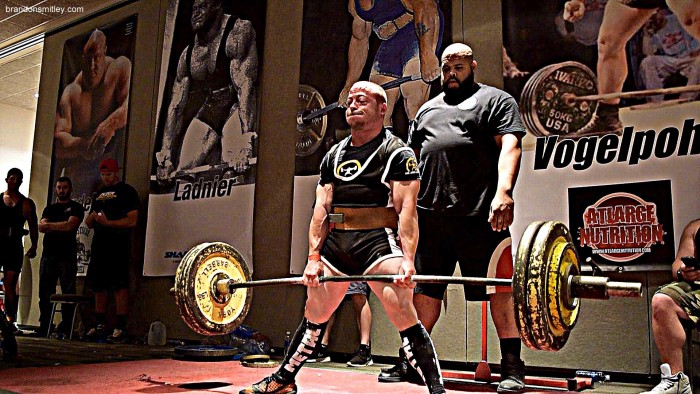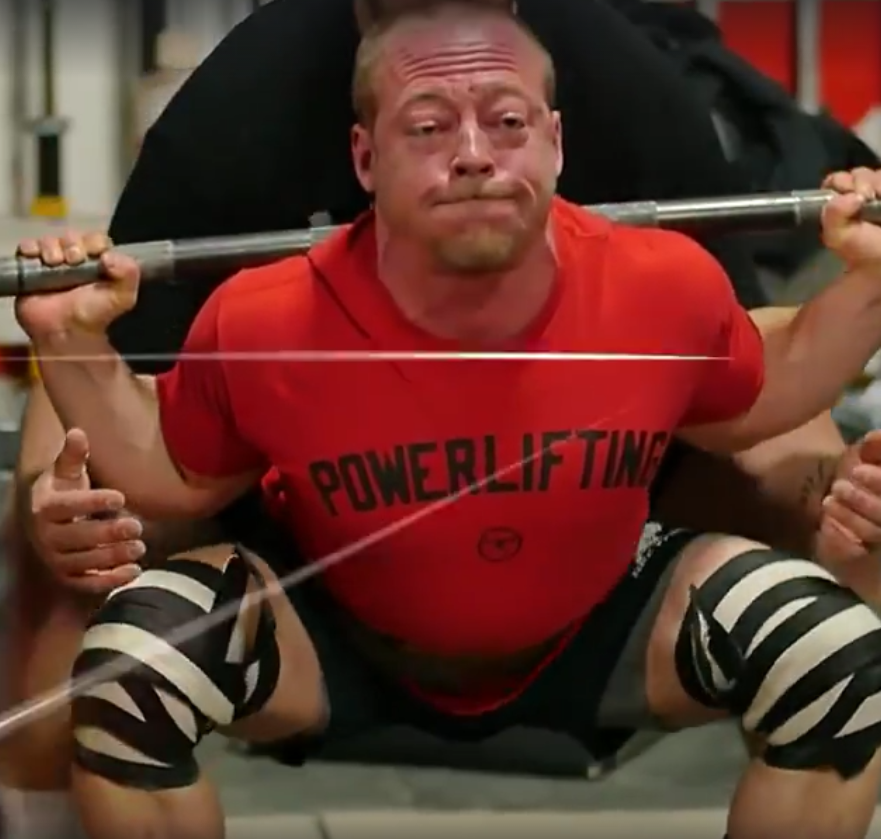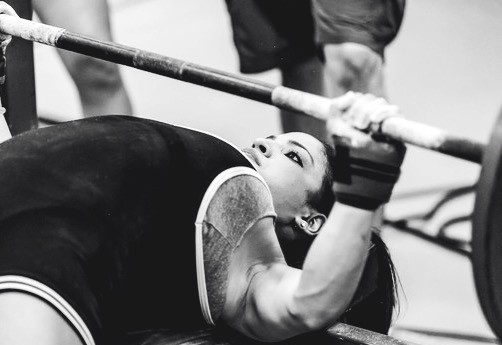
Have you ever seen that guy who lifts easy 700lbs (whatever the lift, this is hypothetical) at the gym or in videos and just bombs out with 600lbs at the meet? Does it again at another meet?
You know him, you know his training is good and well planned, he’s pretty strong, his nutrition was impeccable and yet, his performance is either totally random or consistently a disaster.
So you scratch your head and remember Ed Coan’s words in Power Unlimited: “if your training went well, your nutrition was good, there’s no reason you should miss a lift”.
What in the Iron Gods’ name happened up there at the platform, then? You figure there’s some missing link here to explain competitive success or failure. And there is.

What determines competitive success?
We are used to one answer to this question: talent.
“Why does that girl always win, break records, “does her thing” at the platform?”
“Oh, she’s strong. She’s got it in her. She has talent”.
In every competitive activity, success is usually associated to some inherent quality that determines that individual’s superiority over the others. According to this view, some people would be born like this and that is what makes them successful.
This is a particularly relevant issue in sports, but it can be applied to any activity where mastery over certain skills or capacities is put to the test in a specific moment (“tests of performance”).
Let us use an example from outside the sports in order to explore the components of competitive success. Let us examine test anxiety in admissions tests (GRE, MCAT, LSAT and others). We typically have thousands of graduates and senior undergraduates applying for admission with a varying candidate/position ratio. The more highly recognized the program, the higher the ratio. Each applicant gets to the test with her own qualities developed throughout her life, a certain level of preparation and she sits for a number of hours to answer questions. What determines she will be accepted in the program?
For methodological purposes, let’s assume applicants of the same ethnicity, nationality and physical health to exclude any discussion about policies that may apply in the selection process.
“She’s bright”, we may hear.
“He wasn’t sufficiently prepared”, we may also hear.
“He freaked out”.
This observation brings forth another variable at play for competitive success. In this last case, in spite of being smart, of having an adequate educational background, of being well prepared, the candidate failed the test (“freaked out”).
A competition is a “test of performance”. In this type of activity, the candidate (“competitor”) id tested as to that activity’s requisite skills in a specific date, pre-established conditions and judging criteria. In a direct or indirect manner, the candidate/competitor runs against others, be they physically present or not.
Success in a test of performance depends not only on the skills and qualities the person was born with, acquired and developed (talent). Under the generic term “preparation” are some of the commercially most relevant elements for success in tests of performance. In our admissions tests example, preparation is academic education. As smart as the applicant may be, failure is almost certain in case he is not academically prepared for that specific test.
Prior to the test, it is expected that the applicant has received an education in which he was exposed to challenges similar to those he will face on the test. Without such “rehearsals”, there is no performance. A test of performance, by definition, does not test anything new in the applicant’s repertoire of skills and knowledge.
Besides talent and preparation, the candidate must have certain cognitive and emotional skills to handle the test of performance itself. The harder the competitive pressure, the more equally talented and well prepared will be the opponents. Under these circumstances, COMPETITIVE READINESS will be the most determinant factor. Competitive readiness is this set of skills strategically employed in the act of competition.
talent
Optimizing competitive success in sport became the focus of attention ever since sport became a commercially and strategically important activity. The initial target was talent. Two strategies stood out as dominant: the observation of “success in action” and the attempts to identify talent before the athlete has the opportunity to show outstanding competitive performance. Sometimes even before he is an actual lifter.
Identifying “success in action” still plays a major role in talent screening. One example of that outside the Iron Arts are the scouts that visit highschools and watch games to find potential players. This approach has also been called “natural selection” since it refrains from interfering (or even studying) in the many factors that actually determine that the athlete ends up in that specific sport being observed. Once there, his talent will be noted and analyzed.
This strategy efficacy is undeniable. It works, it has worked in the past and will always work.
Most of us, lifters, were drawn into powerlifting in this fashion. Someone noticed we were “pretty strong” and invited us for a training session, a local meet or even adopted us at a gym.
We were there to be observed. By there I mean under a loaded bar, which is equivalent to the basketball player’s court or the fighter’s mat.
The six million dollar question is: why is that athlete there in the first place? Why is he so good at it?
The first attempts to answer these questions sound naïve today. Looking at a team of boys playing basketball, it became clear that the tallest had an advantage. Along similar lines of observation, the anthropometrical screening was established. Children were evaluated as to their sports “talent” based on anthropometric screening initiatives and maybe some basic physical test. The smallest and more flexible were directed to gymnastics, the tallest to basketball. Talent became “genetics for the layperson”. In other words, phenotype.
With the evolution of research in identification, selection and sports talent screening, increasingly funded by government grants from the powers in war (cold and Olympic) and, more recently, by the enormous commercial interests at stake, new criteria were added to that. A “scientific” selection of talents now includes standardized psychological testing. The selection of athletes based on these more detailed criteria was called “talent detection”, as opposed to the more simplified “talent identification”.
Standardized psychological tests were designed to identify individual attitudes and behaviors that would make the candidate better equipped to certain tasks or positions, in a given sport.
The argument in favor of these techniques is that they would be more efficient, cheaper and would have a higher success rate. All such talent screening approaches applied even before the potential athlete is even aware of his “chosen” sport take for granted that talent is something that dwells inside the subject. It was born with him and the pair athlete/sport were physiologically and psychologically made for each other in a passive manner.
Of course, for the athlete, this seems somewhat intuitive. Who hasn’t at least thought: “I was born to lift”? Who hasn’t looked at their favorite lifter and simply couldn’t imagine him or her doing anything except lift.
However, we overlook the fact that it took many years for this pairing to develop and that even the most awesome lifters started lifting just a few pounds, often skinny kids at the gym.
The above mentioned approaches disregard the collective construction of talent and the emotional and life history elements that format the individual’s relationship with a given activity. It is that connection that makes him especially skilled and even especially likely to win. They also neglect the individual’s choices active role in the expression of excellence.
According to those views, society would be made of half a dozen geniuses and millions of mediocre people because this would be natural, biological and a species feature. The social need for this order to be one way or the other, the construction of geniuses, the availability of valued versus undervalued skills – all this remains opaque under such perspective.
Talent identification/detection techniques contain a half-told story. Besides that, they are hardly efficient in the identification of competitive readiness. This last component of competitive success not only is not innate, but it changes in time.
How else can we define talent?
The most visible consensus in the literature about talent is the idea that it is a set of attributes that makes it possible for the individual to express excellence in a given skill. Part of the published studies distinguish talent from competitive success.
Would it be possible to speak about talent in the absence of its material manifestation? Would there be a “football talent” in someone who has never seen a ball in the field? The advocates of the “scientific talent detection” would say “yes”. I say no. Certain skills and capacities allow us to predict with varying accuracy that a given individual will: 1. Have increased motor learning for certain sports gestures; 2. Have a playing attitude consistent with that sport. Whether he will actually display talent in the court, field, platform, pool, etc. (without the pressure of having been screened for that) is unpredictable.
I believe we can safely assume that talent exists. I also think it is reasonable to assume that, as with most human faculties, it is the product of the interaction between nature and nurture. The volleyball player’s height and the gymnast’s flexibility are obviously genetic. There probably are many genetic determinants for strength in specially gifted lifters. However, the expression of the technical skills involved in the excellent execution of a motor script and the technical mastery of a motor repertoire are not genetic.
Is talent physical, cognitive, emotional or cultural? Another wrong question. These factors are strictly inseparable. What is the emotional component of a dancer’s talent? What about a figure skater’s, a fencer or a judo fighter? What about us? What deep rooted emotions drives us to the limits of human strength? How much physical is it? Cognitive? How cultural is the basketball or football player’s talent, expressed in the underprivileged boy from a poor neighborhood, brought up in an environment where sport is the chief ladder out of social exclusion and poverty? What about the Basque Country Games’ athlete? What is he motivated by, besides patriotic pride?
The most relevant questions to ask about in the study of competitive success, I believe, are related to motivation. The knots we need to untie to give the athlete control over his competitive readiness require that he understand as well as possible the components of his intrinsic and extrinsic motivation. Such motivation components were present at the construction of talent itself, when the athlete had his first emotional and concrete contact with the activity that would become, slowly and increasingly dominant, the core of his identity: the moment of choice.
Regardless of our muscular short limbs or our actual strength, one day we chose to express it by squatting under, pressing and pushing loaded bars. That is when our talent took form.

SPORT – PREPARATION
It is said that “luck is what happens when preparation meets opportunity”. I decided to investigate the origin of this statement. It is attributed to Seneca, roman philosopher from the first century before Christ. Apparently, this same phrase has been reproduced, in different forms, in English language texts since the beginning of the XXth century. It seems that the exact form that became popular to this day is derived from these sources, and not from Seneca. The evidence connecting the phrase to Seneca is his citation of Demetrius, the Cynic:
“The best wrestler,” he would say, “is not he who has learned thoroughly all the tricks and twists of the art, which are seldom met with in actual wrestling, but he who has well and carefully trained himself in one or two of them, and watches keenly for an opportunity of practicing them.” — Seneca, On Benefits, vii. 1
It seems the idea comes from a lot of different places, perhaps because there is some deep wisdom in it: a game implies the unpredictable, by definition, otherwise it wouldn’t be one. To deal with unpredictability, the player – however talented he is – must be prepared.
Preparation is the set of planned actions, organized in time, targeting the competitive challenge. Such actions address the largest possible number of predictable items. Preparation includes:
- Physical preparation: conditioning – the athlete must be physically conditioned in order to recruit and employ technical and mental skills with the highest efficiency.
- Technical preparation – it is the part of the athlete’s training dedicated to learning, consolidating and improving the sport specific gestures.
- Physical preparation: nutrition – the athlete’s nutrition must be planned to optimize training and competition during the whole pre-contest period.
- Physical preparation: clinical monitoring – as every human being, the athlete’s physiological indicators respond to stimuli and must be monitored to optimize performance.
- Physical preparation: pre-habilitation – strategies involved in injury prevention.
- Psychological preparation – the training of cognitive and emotional skills involved in training and in the competitive situation. Psychological preparation includes, among other things, the identification and optimization of each type of response to a training or competitive situation; the identification of detrimental attitudes and behaviors and those conducive to performance in training and in competition; the preparation for the competitive event itself, meaning the construction of optimal competitive readiness.
Preparation could be divided into three major groups with a great deal of overlap and interfacing:
- Physical preparation
- Technical preparation
- Psychological preparation
Like talent, preparation does not guarantee competitive success but is a precondition to it. Preparation manages predictable variables that take place during the “test of performance”. It also guarantees the best physical and mental conditions for the manifestation of competitive readiness.
Until recently, most powerlifters would dispute the relevance of physical or psychological preparation. Today, most wise lifters and coaches are aware that they always take place. Whether they are good or bad, intuitive or planned, is a matter of recognizing they exist and need attention. The years when powerlifting diet was equal to trash food are over. Most lifters are also aware that ritualizing psyching up or focus technique is psychological preparation, whether it is done by coaches and team mates or conducted by a professional psychologist.
SPORT – COMPETITIVE READINESS
At this point we get to the third determinant factor for competitive success: competitive readiness. Competitive readiness is the condition of mastery and optimization of a repertoire of responses to the demands of a given “test of performance” (competition). It is a psychological condition where cognitive and emotional skills are put into action to produce such responses. As much as an athlete may be talented and as best as he may be prepared, if he lacks competitive readiness, success is unlikely.
There is no consensus about which these skills may be. They should include:
- Control over sensorial input. For certain tasks, it is necessary to have maximum acuity concerning sensorial input, as well as prompt and energetic response. For others, it is precisely the opposite: success is associated with funneling perception and blocking sensorial input. Examples of each case are basketball passes versus a foul shot. Different sports require different types of sensorial selection, such as the fights. Others require extreme forms of sensorial selection and blocking, with a dominant internal focus, like powerlifting, weightlifting, diving and shooting sport.
Take the course of a powerlifting round, for example. As it proceeds towards the athlete being called to the platform, different forms and levels of sensorial input screening are expressed. The lifter cannot fail to hear his name being called and noticing the approach of the moment. He must be 100% ready, belt buckled, wraps wrapped and whatever needs to be done, done. As he walks the few feet that separate the entrance to the platform and the bar, the optimal sensorial input screening is operant. He must hear only the referee’s commands (and maybe a few from his coach).
- The ability to produce the required type of focus for each competitive situation.
- Response to unpredictability:
- Acceptance – the ability to accept or react serenely towards unpredictable situations (different support, monolift, bar, lights, delays, temperature, etc.)
- Objective processing of new information (analyzing the different support at warm-up and adjusting to it, developing strategies to deal with unpredicted temperature, etc.)
- Adequate response to the new situation
- Emotional control when facing competitive disadvantage or advantage during the game, set or round: not feeling overwhelmed by disadvantage, as a foreboding of defeat, nor anxious or elated with advantage, as a presage of victory. The optimal state is that which is the least vulnerable to disturbance during the competition.
- Control over interpersonal interaction. During a competition, the least predictable input and, consequently, one of the worst sources of disturbance to the competitive script is “the other”: the other player, coach, officers or even team mates. The least the other’s emotion (anxiety, anger, joy) influences the athlete’s performance, the least the disturbance over the competitive script.
- Decreased sensibility and responsiveness to autogenic reactions such as fatigue, pain, hunger, etc.
- Being “into” (present) the competitive action the whole time.
More research into the peculiar mental state conducive to competitive success should reveal more skills to this list, as well as organize the identified ones. In general, it is safe to say that competitive readiness consists in producing in oneself such mental state and maintaining it until the end of the competition.
Also, how each person may come to master the specific techniques involved in readiness is unique to that lifter, as is the emotional and life history blueprint that will guide the construction of the skills themselves.
So, when we hear the speaker call “the bar is loaded”, being ready means much more than having your belt buckled or your wrist wraps fastened. It means full powerlifting mode ON – whatever it means for each lifter.
source: http://www.mariliacoutinho.com/









1 Comment